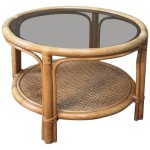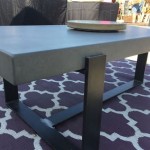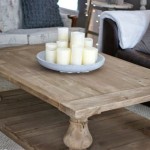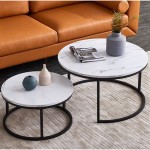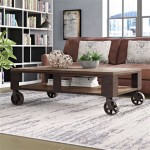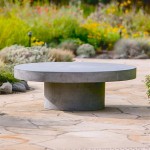How to Make a Round End Table
Constructing a round end table offers a practical and aesthetically pleasing addition to any living space. This project, while requiring patience and precision, is achievable for individuals with intermediate woodworking skills and access to essential tools. The process involves carefully selecting materials, accurately cutting and assembling the various components, and applying a protective finish. This detailed guide provides a comprehensive overview of the steps involved in creating a sturdy and visually appealing round end table.
The design outlined here focuses on a simplified approach, prioritizing ease of construction without compromising structural integrity or aesthetic appeal. The table will consist of a round tabletop, a supporting apron, and four legs securely attached to the apron. Modifications to dimensions and design elements can be easily implemented to personalize the project and match specific stylistic preferences.
Preparation and Material Selection
Before commencing any woodworking project, thorough preparation is crucial. This includes accurately planning the dimensions of the end table to suit the intended space and intended use. A common height for end tables ranges from 22 to 26 inches, but this can be adjusted based on personal preference and the height of adjacent furniture, such as sofas and chairs. The diameter of the tabletop will also influence the overall aesthetic and functionality of the table. A diameter between 20 and 24 inches is generally considered suitable for a standard end table.
Material selection is another critical aspect of the preparation phase. Hardwoods such as maple, oak, cherry, or walnut are excellent choices for their durability and aesthetic qualities. Softwoods like pine can also be used, but they are more susceptible to dents and scratches. The choice of wood will significantly impact the final appearance and longevity of the end table. Consider the grain pattern and color of the wood to complement the existing décor. In addition to the primary wood species, screws, wood glue, sandpaper of various grits (80, 120, 220), and a suitable finish (stain, paint, varnish, or polyurethane) will be required.
A comprehensive list of tools is also necessary. These typically include a circular saw or table saw, a jigsaw, a router (optional, for edge profiling), a drill, a sander, clamps, a measuring tape, a pencil, and safety glasses and hearing protection.
Constructing the Tabletop
The first step in constructing the round end table is to create the tabletop. If using solid wood, several boards may need to be glued together to achieve the desired width. When gluing boards together, ensure that the edges are perfectly straight and aligned. Use clamps to apply even pressure across the entire surface and allow the glue to dry completely according to the manufacturer's instructions. Once the glue is dry, remove the clamps and sand the tabletop to create a smooth, even surface.
To create the round shape, use a compass or a circular template to draw a circle on the tabletop. A simple jig can be made by attaching a pencil to a string and anchoring the string at the center of the tabletop. Carefully cut along the marked line using a jigsaw. It is essential to cut slowly and steadily to avoid splintering or uneven edges. After cutting, use a sander to smooth the edges of the tabletop and remove any imperfections. If desired, a router can be used to create a decorative edge profile, such as a roundover or chamfer.
Alternatively, pre-made round tabletops can be purchased from various woodworking suppliers. This option can save time and effort, especially for those who do not have access to the necessary tools or experience to create a round tabletop from scratch.
Building the Apron and Attaching the Legs
The apron provides structural support for the tabletop and serves as the attachment point for the legs. The apron typically consists of four pieces of wood cut to the appropriate length and joined together with mortise and tenon joints, dowel joints, or pocket hole screws. The length of each apron piece will depend on the diameter of the tabletop and the desired overhang. A common overhang is between one and two inches.
Cut the apron pieces to the required length and width. The width of the apron should be sufficient to provide adequate support for the tabletop and to allow for secure attachment of the legs. Once the apron pieces are cut, join them together using the chosen joinery method. If using mortise and tenon joints, cut the mortises and tenons accurately and ensure a snug fit. If using dowel joints, drill the holes for the dowels and glue the dowels in place. If using pocket hole screws, drill the pocket holes and assemble the apron pieces using screws and glue. Ensure that the apron is square and that all joints are securely fastened.
The legs can be made from square or tapered stock. The length of the legs will determine the height of the end table. Attach the legs to the apron using screws and glue. One common method involves using corner blocks that are glued and screwed to the inside corners of the apron and to the legs. This provides a strong and stable connection. Ensure that the legs are evenly spaced and that the table is level before tightening the screws.
Another method involves using mortise and tenon joinery to attach the legs directly to the apron. This method requires more skill and precision, but it results in a stronger and more visually appealing connection.
Assembly and Finishing
After the apron and legs are assembled, attach the tabletop to the apron. This can be done using screws, wood glue, or a combination of both. A common method is to use figure-eight fasteners, which allow for seasonal movement of the wood. These fasteners are attached to the inside of the apron and engage with slots cut into the underside of the tabletop. This allows the tabletop to expand and contract without cracking the apron.
Before applying the finish, thoroughly sand the entire end table to create a smooth surface. Start with a coarser grit sandpaper (80 or 120) to remove any imperfections and then progressively move to finer grits (220 or higher) to achieve a smooth, polished surface. Remove all sanding dust with a tack cloth before proceeding to the finishing stage.
The choice of finish will depend on the desired aesthetic and the intended use of the end table. Stain can be used to enhance the natural grain of the wood or to change its color. Paint can be used to create a more contemporary or colorful look. Varnish or polyurethane provides a durable and protective coating that will resist scratches, water stains, and other types of damage. Apply the finish according to the manufacturer's instructions, ensuring that each coat is allowed to dry completely before applying the next. Multiple coats may be necessary to achieve the desired level of protection and sheen.
Between coats of finish, lightly sand the surface with fine-grit sandpaper to remove any imperfections and to create a smooth surface for the next coat. After the final coat of finish has dried, the round end table is complete and ready for use.

Easy Diy Round End Table

Build A Round Side Table Building Plans And Instructions By Buildbasic Www Basic Com Diy Bedroom Design

Diy Wood Circle Side Table Liz Marie Blog

Diy Flush Side Round End Table Muslin And Merlot

Diy Round Coffee Table

How To Make Your Own Chic And Classic Diy Round Side Table Habitat By Resene

Diy End Table Angela Marie Made Tables Side Round

5 Brand Name Inspired End Tables That You Can Build Yourself For Less

Easy Diy Side Table Made From Something Unexpected

How To Create A Beautiful Family Room Side Table Decor Home
Related Posts


